#French Resistance
Text


May his memory be a blessing.
5K notes
·
View notes
Text
Meet Edgar Morin - a 102-year-old Jewish veteran of the French Resistance, a renowned philosopher, and a strident voice for justice. It truly upsets me that I’d never heard of this incredible man till now.
“I am both astonished and outraged by the fact that those who represent the descendants of a people who were persecuted for centuries for religious or racial reasons... That the descendants of this people who are today the decision-makers of the State of Israel, could not only colonize an entire people, partly drive them out of their land and seek to expel them for good... But also, after the massacre of October 7, engage in a real massive slaughter on the population of Gaza and continue, incessantly, hitting civilians, women, and children.
And to see the silence of the world, the silence of the United States, protectors of Israel, the silence of the Arab states, the silence of the European states who claim to be defenders of culture, humanity, human rights.
I think we are living through a horrible tragedy because we are also powerless in the face of this thing that is unleashing. At least, I say: bear witness! The only thing that remains if we cannot resist concretely is to TESTIFY. Let’s RESIST IN OUR MINDS, let’s not be fooled, let’s not forget, let’s have the courage to face things head-on.”
Repost from @middleeasteye
“After the massacre of 7 October, (Israel) engaged in a real massive slaughter on the populations of Gaza.”
French philosopher Edgar Morin, a Jewish WWII resistance fighter, criticised Israel’s actions in Gaza. He expressed disappointment at the silence of countries like the United States, Arab and European nations, whom he referred to as “protectors” of Israel.
#jewsforpalestine #jewsagainstzionism #gaza #gazagenocide #humanrights #palestine #freepalestine #freegaza #freethewestbank #israel #crimesagainsthumanity #antifascist #solidarity #ceasefirenow #neveragain #neveragainisnow
#free palestine#palestine#human rights#Gaza#jews for palestine#edgar morin#gaza genocide#jews for ceasefire#jewish antizionism#antizionist jews#resistance#save gaza#free gaza#french resistance#judaism#never again#never again for anyone#never again is now#ceasefire now#stop the genocide
285 notes
·
View notes
Text







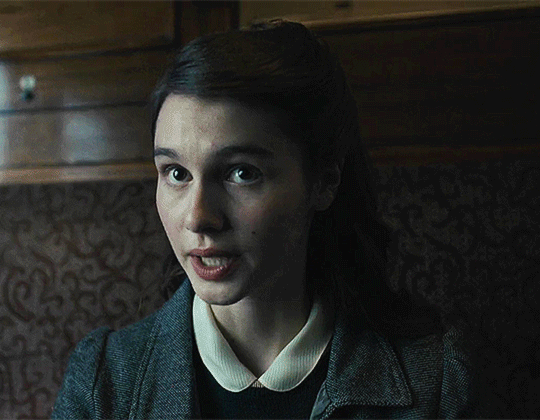
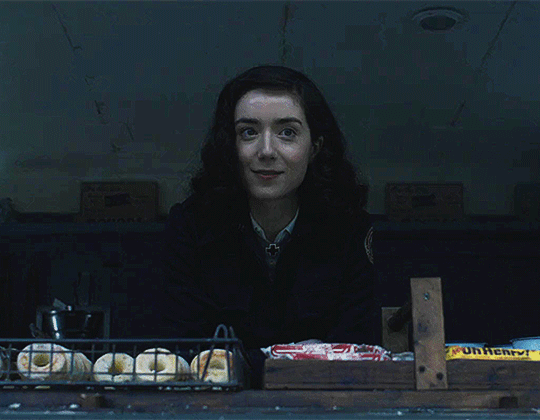

The Women of Masters of the Air - 1x04
Civilian
French Resistance
Red Cross Clubmobile
Civil Defense Service Air Raid Warden
#motaedit#masters of the air#masters of the air spoilers#mota#mota 1x04#women of mota#women in wwii#my gifs#mod post#french resistance#red cross clubmobile#civil defense#air raid warden#women's history#the women of masters of the air
129 notes
·
View notes
Text

Members of the French Resistance discuss the military situation with paratroopers of the U.S. 82nd Airborne Division during the Battle of Normandy, June 1944. Photo credit: U.S. Army Signal Corps / Regional Council of Basse-Normandie / National Archives USA.
#history#military history#WW2#WWII#World War Two#Second World War#D-Day#Normandy Landings#French Resistance#photography#lest we forget
259 notes
·
View notes
Text
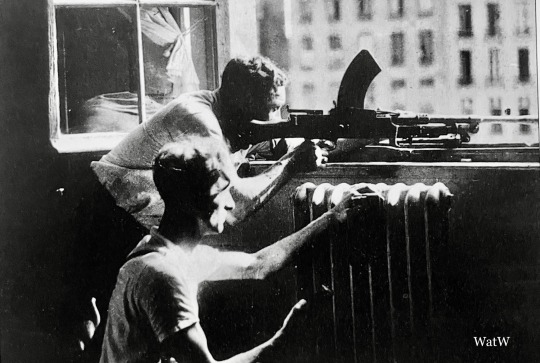
Members of the French Resistance in action during the liberation of Paris - August 1944
#world war two#1940s#worldwar2photos#history#ww2#wwii#ww2 history#wwii era#world war 2#ww2history#liberation#liberation of france#1944#liberation of paris#Paris#France#french resistance
166 notes
·
View notes
Text
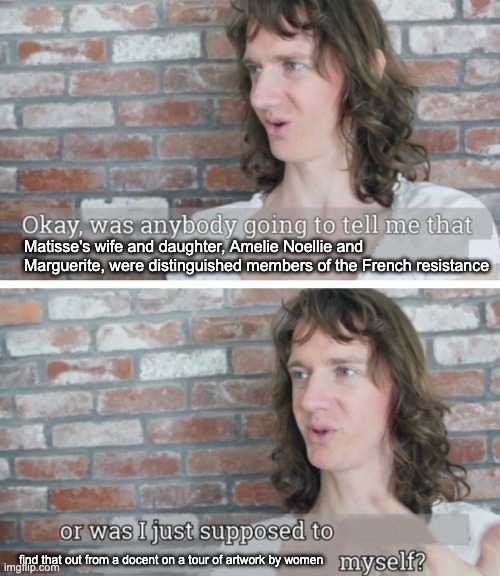
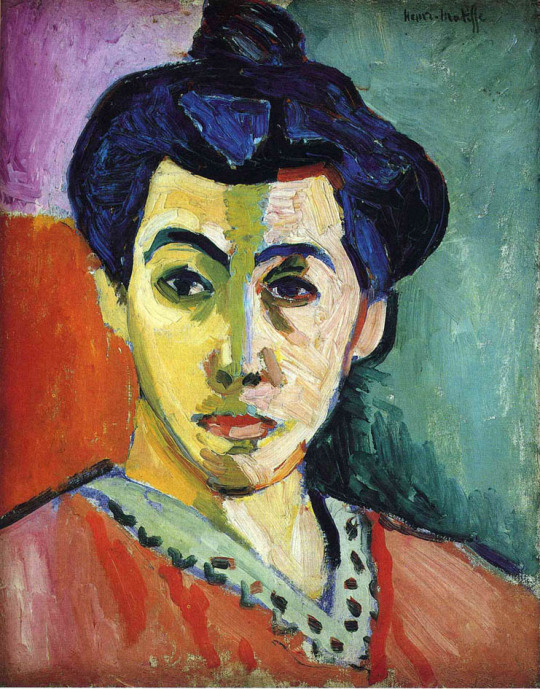

#marguerite matisse#henri matisse#amelie noellie matisse#ww2#french resistance#world war 2#world war ii#wwii#women in art#women in history#post#gayle meme#gayle waters waters meme#chris fleming#gayle waters waters#was anyone going to tell me#or was i just supposed to#20th century#history memes
86 notes
·
View notes
Text
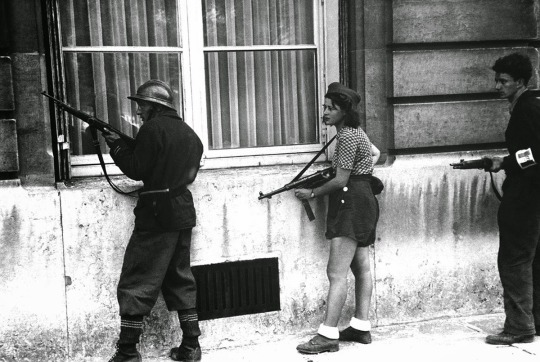
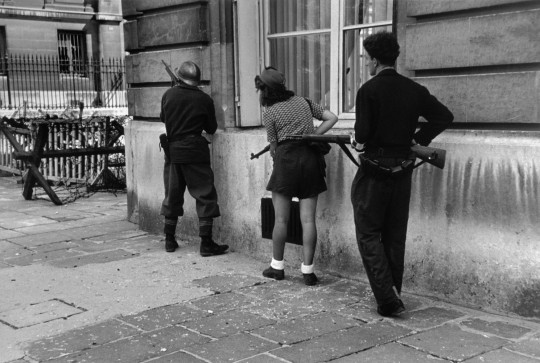
Après son entrée dans Paris avec les troupes de la 2e Division blindée, Simone Segouin, résistante française dans les Francs-tireurs et partisans (FTP), et deux de ses camarades participent à l'élimination des dernières poches de résistance – Libération de Paris – Opération Overlord – Août 1944
Photos Robert Capa
©Magnum photos
Simone Segouin rejoint les Francs-Tireurs et Partisans en 1944 à l'âge de 18 ans sous le pseudonyme de Nicole Minet. Après de nombreuses missions en tant qu'agent de liaison entre Dreux, Chartres et Châteaudun, les FTP lui propose de prendre les armes et devient l'une des rares femmes à prendre part aux combats. Attaques de convois, de trains, de détachements ennemis et opérations de sabotage lui valent le respect au sein de la résistance.
Elle participe activement à la libération de Chartres et s'illustre le 20 août 1944 en prenant part à la capture de 25 allemands à Thivars, à 7 km au sud de Chartres. A cette occasion elle récupère un pistolet mitrailleur MP40 avec lequel elle pose fièrement lors de la venue du Général de Gaulle à Chartres le 23 août pendant sa tournée d'inspection des régions libérées.
A la suite de cette cérémonie, les différents groupes de résistants du département prennent la direction de Paris pour participer aux combats insurrectionnels. La plupart regagnent Paris et font la jonction avec la 2e Division blindée de Leclerc le 25 août à six heures du matin.
C'est la raison pour laquelle, un cliché de Robert Capa présente Simone Segouin aux côtés de deux de ses camarades face aux dernières poches de résistance allemande.
Sa conduite valeureuse dans la clandestinité et son action dans les combats de la Libération lui valurent le grade de sous-lieutenant.
Elle fût décorée de la croix de guerre par Charles Tillon, ministre de l'Armement et ancien chef des FTP le 24 mars 1946 à Chartres.
#WWII#opération overlord#operation overlord#overlord#libération de la france#liberation of france#libération de paris#liberation of paris#résistance#resistance#résistance française#french resistance#francs-tireurs et partisans#ftp#femmes dans la guerre#women in war#figures historiques#historical figures#simone segouin#paris#france#août 1944
19 notes
·
View notes
Photo

Θαρσείν χρη, τάχ’ αύριον έσσετ’ άμεινον. Eλπίδες εν ζωοίσιν, ανέλπιστοι δε θανόντες.*
- Theocritus
You need to have courage, because tomorrow will be better. While there's life there’s hope, and only the dead have none.*
My ex-regiment proudly traces its lineage back to the Glider Pilot Regiment which spearheaded British airborne forces to take Pegasus Bridge on D Day 6 June 1944. During my service I had the privilege to travel there and take part in the commemorative ceremonies whenever D Day came around. I loved listening to the stories of some of the surviving veterans and also some of the local French too. The British taking of Pegasus Bridge - re-named partly after the emblem of pegasus of airborne forces - was one of the stand out events of the first days of D Day by British forces.
Airborne landings in the British Sector were targeted mainly at the Orne River/Caen Canal crossings and the artillery installations of the Merville Battery. The strategic purpose was to secure river crossings for the beach break-out and to reduce enemy defences.

At 00:16 hours on 6th June parachutists and gliders from the Airborne Division, consisting of D Company of the Oxfordshire & Buckinghamshire Light Infantry, began to land east of the River Orne and the Caen Canal.
The small force of 181 men was commanded by Major John Howard and joined with a detachment of Royal Engineers who landed at Ranville-Benouville in six 28-men Horsa gliders. Having taken off from Dorset, the gliders were towed across the Channel by Halifax Bombers. With perfect navigation and piloting skill, the gliders landed on time and on target within few yards of each other.
Major Howard’s glider landed within a few feet of the canal bridge. The bridge was captured after a fierce ten minute fire fight, the action all over by 00:26, a full six hours before the beach landings.
But the success of the mission was also down to intelligence gathered by locals and passed onto British intelligence through the French resistance channels.
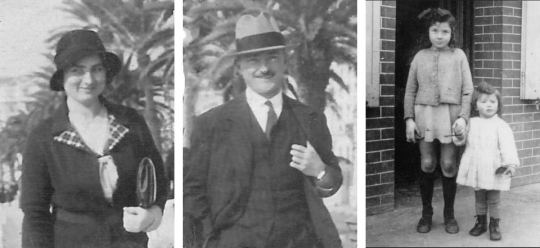
One of these was Georges Gondrée and his wife, Thérèse. Georges and Thérèse moved to Bénouville where they bought a small café in 1934 on the shore along the Bénouville Bridge, called Café Gondrée. During the Invasion, they had three small daughters: Georgette, Arlette, and the newborn Françoise.
The family certainly hated the German occupation. Among other things, they refused to allow their café to serve as a billet for German soldiers. But they went further by joining the French resistance at great danger to themselves.
As the war progressed, the more risks and dangerous activities they undertook against the Germans. Thérèse, who grew up in Alsace, knew quite a bit of German. Local residents did not like her Germanic Alsatian accent but she took care to keep her knowledge of German secret from the German soldiers themselves. This often helped her to eavesdrop on conversations of the soldiers and then pass on important information to the resistance through her husband, Georges. There were a few times when they were nearly caught but somehow they survived.
The information gathered by the Gondrée family contributed greatly to the insight of Major Howard and his troops to better assess the defensive positions around the bridge. Among other things, Thérèse was able to pinpoint the exact location of the detonator that was supposed to have detonated the bridge during the attack. Georges was also known to British intelligence and even Major Howard had heard his name mentioned during the planning of the invasion itself.
The importance of the family’s contribution to the success of the British attack can also be seen from an example during early May 1944. When Field Marshal Erwin Rommel came to inspect the bridge, he had given the order to place an anti-tank gun beside the Bénouville Bridge. Within two days Major Howard had been informed that a new structure was being built along the bridge and within a week Georges’ observation had helped to confirm both its function and exact location.

So, just 90 minutes after taking off from RAF Tarrant Rushton in England, Major Howard was able to send the code words “Ham and Jam”, indicating that both bridges had been captured. In this early action of D-Day, the first house on French soil was liberated, and the first British soldier of the Normandy Invasion was killed in action: Lieutenant Den Brotheridge.
It was No. 1 Platoon which knocked out a machine gun position firing from the bridge and rushed across to capture the far side, firing from the hip and lobbing grenades during the charge. Lt. Brotheridge was mortally wounded by gunfire as he made a grenade attack on a second machine gun position. The bridge had been prepared by the enemy for demolition, although the Royal Engineers removed the unset charges.
Within half an hour of the bridge being taken, 6th Airborne parachutists landed to provide reinforcement. The Ox & Bucks were reinforced half-an-hour after the landings by 600 men of 7th Battalion, the Parachute Regiment who were the relieving force to bear the brunt of German counter-attacks to the west of the Caen Canal throughout the 6th of June.
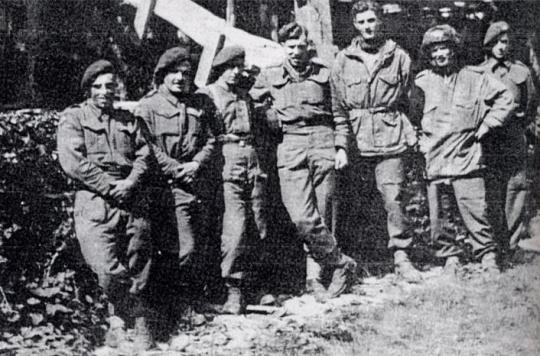
The Battalion distinguished itself in holding a wide bridgehead around ‘Pegasus Bridge’ against constant enemy attacks which were often armour supported. In particular the “A” Company, based in the nearby village of Bénouville, suffered the most severe fighting and were eventually cut off from the remainder of the 7th Battalion.
The first relief in force was from 6 Commando, led by the commander of the 1st Special Service Brigade, Lord Lovat, who arrived to the sound of the Scottish bagpipes, played by the 21–year-old so-called ‘Mad Piper’, Private Bill Millin.
The remnants of the 7th Battalion’s “A” Company continued to hold out until 9:15pm on the 6th June when British infantry, in the form of the 2nd Battalion The Royal Warwickshires, arrived from the invasion beaches and secured Bénouville, and so allowed the evacuation of “A” Company’s many wounded.
In honour of the distinctive emblem of the Parachute Regiment, the distinctive bridge at Benouville was renamed and will forever be known as “Pegasus Bridge”.

Arlette Gondrée being kissed by two veterans who remember her parents.
Over the years, many thousands of pairs of British boots have crossed the threshold of the Café Gondrée. General Montgomery in 1945, veterans paying tribute to fallen comrades and numerous members of the Royal family. Arlette Gondrée, the daughter of Georges and Thérèse, still recalls with crystal clarity the very first occasion a British soldier arrived at the cafe on the night of June 5, 1944, when she was just four-years-old, cowering with her family in the basement during the start of the D-Day invasion.
Commemorating the landings in 1945, General Montgomery visited the Café Gondrée Pegasus Bridge, renamed after the winged emblem of the British 6th Airborne Division, with some widows of the soldiers lost in the Normandy campaign. Georges produced some of the vintage champagne he had hidden, including a 1926 Pouilly-Fuissé.
Over the ensuing years, the family never ceased to celebrate their liberation. “Daddy would make a large U-shaped table in the café and we would eat together as a happy family, and very, very thankful to the British for what they did for us. And that remains so to this day.”
Life was hard for years, made worse by rationing. The effect of the ordeal on the girls was subtle, but not invisible: in November 1944, the Red Cross visited and told Arlette if she stopped biting her nails, they would give her a real doll to replace her cardboard toy. The café didn’t open properly again until June 1945.

To this day, Mme Gondrée keeps her “little house” as a shrine to the British Airborne forces that liberated her family. She has said that she always felt honoured to have the privilege of being custodian of the memories of that fateful day.
Photo: Major John Howard is flanked by George Gondrée and Lt. David Woods raising a glass to the successful capture of Pegasus Bridge that day.
#theocritus#greek#classical#quote#D Day#DDay#British army#second world war#pegasus bridge#glider pilot regiment#gondree cafe#georges gondree#therese gondree#arlette gondree#major john howard#lt david woods#military history#french resistance#history#courage#bravery
60 notes
·
View notes
Text
Nicola Trahan, who has died aged 97, joined the French resistance as a schoolgirl and was awarded the Croix de Guerre avec Palme for her bravery during “numerous dangerous missions”, in particular a series of battles between her Maquis and the notorious 2nd SS Panzerdivision Das Reich. After the second world war she settled in the UK, where she served with the Soldiers’, Sailors’ and Airmen’s Families Association (SSAFA) for 50 years.
Aged 16, while still at school in Valençay, Indre, in central France, she joined the Forces Françaises de l’Intérieur (FFI), the resistance organisation run by the Gaullist French authorities in London and known as the Armée Secrète.
According to her French military file, Trahan became a member of the North Indre Maquis, led by Francis Perdriset, a former French army officer who took charge of FFI resistance operations in that area in July 1943. Her main role was as a courier delivering messages twice daily between the various resistance teams.
She also worked as part of the Maquis’ medical team and, amid a heavy German military presence, used her trips cycling between the teams to collect intelligence. A note in a file has one resistance fighter telling another that Trahan would sometimes be late because she liked to sit by the road watching the Germans while eating her lunch. “Don’t worry,” he said. “It provides us with valuable information.”
In an interview with a French newspaper following the liberation of France, Trahan said that once when she was stopped by the Germans she screwed up her FFI identity pass into a ball and swallowed it to avoid arrest. She also recalled taking part in firefights and on one occasion shooting and wounding two German soldiers: “I really liked ambushes; when we put together a team and went off in full truckloads. I had a revolver and a machine gun.”
In July 1944, Perdriset and his Maquis began working closely with a British Special Operations Executive (SOE) officer Pearl Witherington (later Cornioley), who was also based in North Indre.
Witherington had set up the SOE’s Wrestler circuit in May that year. But on 11 June, five days after the D-day landings, she and the small number of resistance fighters she had assembled were attacked by a much larger German force. They fought them off but Witherington decided she needed an experienced military officer to help her to reorganise her forces.
“Finally, on 25 July [1944], after I had asked repeatedly for a military commander, to my great relief one arrived,” she recalled in her memoirs. “He was an army captain called Francis Perdriset.”
From that point on, the North Indre Maquis was closely integrated with the SOE Wrestler team. Trahan recalled meeting Witherington once, at a parachute drop of weapons and other supplies, where resistance members would have been called upon to remove the supplies to a safe location.
Shortly after Perdriset took over as Witherington’s military commander, elements of the German 2nd SS Panzerdivision Das Reich arrived in the region on their way north to Normandy, having been ordered to destroy the resistance along the way.
They had previously massacred an entire village at Oradour-sur-Glane and, from mid-August, launched a series of attacks against resistance groups in the Indre area, most notably in Valençay itself, where Perdriset was present.
“The Germans did a lot of damage in Valençay,” Witherington recalled. “I wasn’t there but Francis was. He was told to stand against a wall, he really thought he had had it. The Germans set fire to things, shot, killed. It wasn’t as bad as Oradour-sur-Glane but it wasn’t a pretty sight.”
In his recommendation for the award of the Croix de Guerre, Perdriset said Trahan, then only 17, “notably distinguished herself at Valençay from 20 to 30 August 1944 by bringing her commander valuable information which she gathered at the heart of enemy operations”.
Born Nicole in Berck-sur-Mer, in the Pas de Calais, she was the daughter of André Trahan, who worked in the insurance industry, and Jeanne (nee Bourzes), a professor of English.
Nicole initially boarded at the Collège Cévenol at Le Chambon-sur-Lignon in south-central France. She later recalled that her parents took her to the UK when the Germans occupied northern France in 1940, but by 1942 she was at Cours Guynemer, a private school in Valençay.
After the war, Trahan went to the Sorbonne to study philosophy but, having decided that it was not for her, she trained as a nurse at the Ecole d’Infirmières des Associations Diaconesses in Paris, and at Brighton General hospital, in East Sussex, qualifying in 1953. She subsequently worked as a health visitor in Cheshire. She anglicised her name from Nicole to Nicola and was naturalised British in 1957.
The following year she joined SSAFA, first as a member of its nursing service, then as a health visitor working with service families in Germany, Belgium and Hong Kong. Trahan served with the association for 30 years and after retirement continued to work for them as a volunteer for a further 20 years.
Trahan settled in Orcheston, Wiltshire, where she was also a volunteer at Salisbury Cathedral, and enjoyed swimming and walking her dog.
In 2005, she was invited to the unveiling by Queen Elizabeth II of the monument in Whitehall to The Women of World War II, followed by a lunch for female veterans at Buckingham Palace. In 2008 she was appointed MBE.
Nicola (Nicole) Marie Pauline Trahan, resistance fighter and nurse, born 21 December 1926; died 18 January 2024
12 notes
·
View notes
Text
Hagio Moto's Egg Stand

I wanted to get Hagio's Houmonsha (訪問者) one shot collection off my reading list, and read this one shot, Egg Stand (エッグ・スタンド) yesterday. This 100-page one shot was first published in Petit Flower's 1984 March issue. It tells the story of a young orphan boy (Raoul), a dancer girl (Louise) and an activist who's part of the French Resistance movement (Marchand) in an occupied Paris.
I cheated and read the French version (Le coquetier) published in the second volume of Hagio's collected works, De l'humain. This actually kind of added to the story, considering that it takes place in France... Anyway... Egg Stand was quite a depressing story on the worth of life and meaning of death, while terrible stuff happens to another Hagio bishounen. I enjoyed reading a serious, historical work by her.
The page I posted above is a reference to Hermann Hesse's Demian and the chick-egg allegory there. Let's refresh our minds:
“If the chick is not able to break the shell of his egg, he will die without being born. We are - chick. The world - is our egg. If we do not break the shell of the world, then we will die without being born.”
This where the main theme of the story comes from: If a chick dies inside its egg without hatching, does it even know it was alive? Does it realize it's dying? What do people feel as they die? What do people feel as they kill others? The chick's world is inside of the shell, and it lives and dies without ever seeing what's outside... Are we not the same? Do we actually break our shells as we "live"? If you don't, can you still call it "living"? Are we dead inside our shells, or are we really alive? While the whole drama might feel like every other WW2 movie, this one shot leaves you with all these questions, and thus is worth reading. I am weak for literary references in manga.
#hagio moto#moto hagio#萩尾望都#エッグ・スタンド#egg stand#24年組#year 24 group#80s manga#80s shoujo#WW2#la Résistance#french resistance#one shot#hermann hesse#demian
28 notes
·
View notes
Text



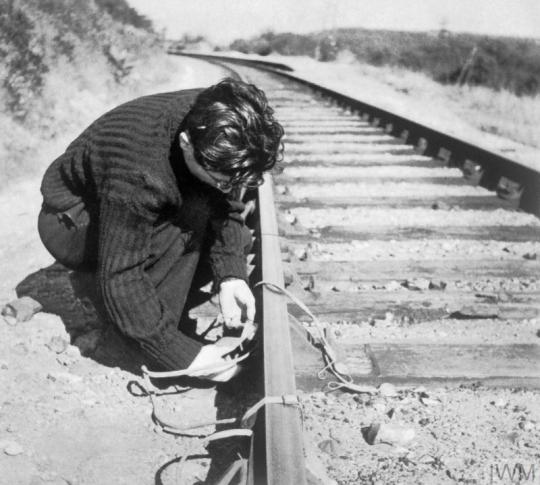
During much of World War II, the French Resistance movement, later known as the French Forces of the Interior, would play a major role in disrupting German Forces, and feeding vital intelligence to Allied forces both before and after the invasion of Normandy. The movement was made up of everyone from civilians to ex-French Military. Often using guerilla tactics and stolen or smuggled equipment, the partisans would strike at German officers, disrupt supply lines, and collect information for the Allies throughout the duration of the war.
7 notes
·
View notes
Text


Simone Segouin, mostly known by her codename, Nicole Minet, was only 18-years-old when the Germans invaded. Her first act of rebellion was to steal a bicycle from a German military administration, and to slice the tires of all of the other bikes and motorcycles so they couldn't pursue her. She found a pocket of the Resistance and joined the fight, using the stolen bike to deliver messages between Resistance groups.
She was an extremely fast learner and quickly became an expert at tactics and explosives. She led teams of Resistance fighters to capture German troops, set traps, and sabotage German equipment. As the war dragged on, her deeds escalated to derailing German trains, blocking roads, blowing up bridges and helping to create a German-free path to help the Allied forces retake France from the inside. She was never caught.
Segouin was present at the liberation of Chartres on August 23, 1944, and then the liberation of Paris two days later. She was promoted to lieutenant and awarded several medals, including the Croix de Guerre. After the war, she studied medicine and became a pediatric nurse. She passed away a few months ago at the age of 98. May her memory be for a blessing.
Rabbi Yisroel Bernath
188 notes
·
View notes
Text
Simone Segouin
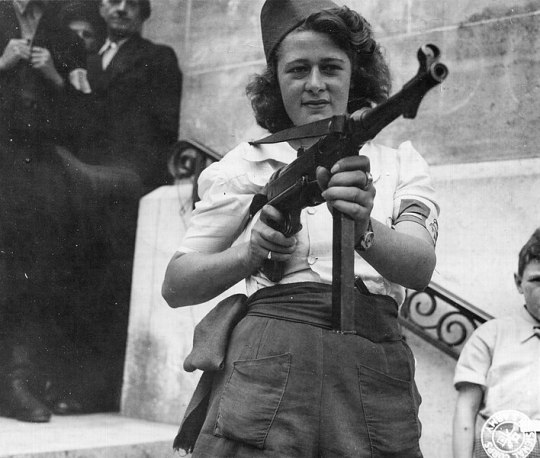
Resistance fighter Simone Segouin was born in 1925 in Thivars, France. When the Nazis occupied France, Segouin, at only fourteen, helped her father shelter and feed resistance fighters. She later became more involved with the resistance, delivering messages and weapons by bicycle to members of a partisan network. Segouin received military training and carried out sabotage against German targets. After the war ended, she was promoted to the rank of lieutenant, and was awarded the Croix de Guerre.
Simone Segouin passed away in 2023 at the age of 97.
Image source: National Archives
26 notes
·
View notes
Text
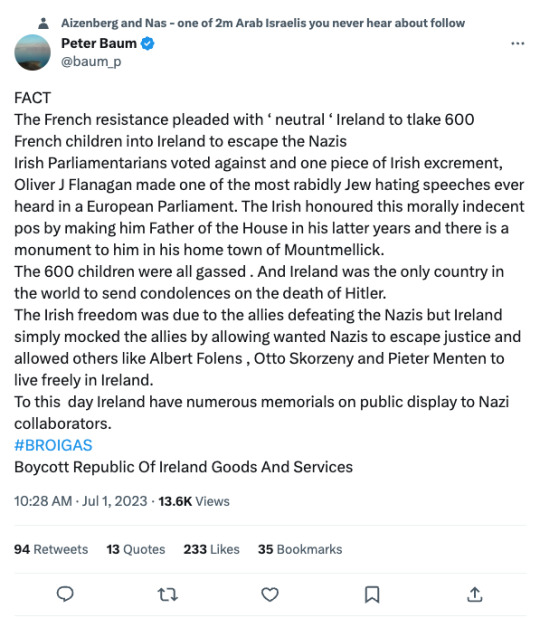
Source
29 notes
·
View notes
Text
Missak Manouchian, an Armenian Genocide survivor who went on to become a French Resistance hero. Born in 1906, Missak arrived in France in 1925 and worked at a Citroën car factory. Despite seeing the true face of evil during the Armenian Genocide, Missak never lost faith in humanity and always believed that a better world was possible. This ideal led him to get involved in politics and join the Communist Party in 1934. When the Nazis occupied France, Missak led a small group of foreign Resistance fighters, who carried out attacks against German forces and risked their lives to liberate the country they loved.
5 notes
·
View notes
